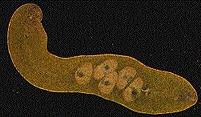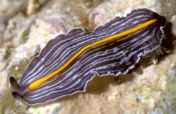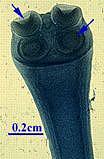Zoology 250 Phylogenetic Trees (2009)

(acoel flatworm)
|

(polyclad flatworm)
|
PHYLUM PLATYHELMINTHES
(Clade for classes and Turbellarian orders
from Nielson 1995 p. 216,
and Ruppert et al. 2004;
4 turbellarian orders are omitted)
|

(trematode fluke)
|

(cestode tapeworm head)
|
Cl. T
==================U============= Or. Catenulida (small, slender, free-living, two cilia/cell)
<<=1=| R
| ==========2a======B=========== Or. Acoela (small body size, gutless)
==| E
| =======2c=======L========= Or. Polycladida (large body size, multi-branched gut)
=2b=| L
| ====2e========A======= Or. Tricladida (the planarians; 3-branched gut)
=2d=| R
| ==2g========IA==== Or. Rhabocoela (small body size, unbranched gut
=2f=|
| ======4===== Cl. Trematoda (endoparasitic flukes)
==3===|
| ==6=== Cl. Monogenea (ectoparasites of aquatic vertebrates)
==5===|
==7=== Cl. Cestoidea (endoparasitic tapeworms)
Back to Zool 250 tree for animal phyla or Protostomia
TRAITS SUPPORTING EACH CLADE(** plesiomorphic- a primitive state, not unique to clade):
1:
a) mid-ventral mouth**
b) blind gut**
c) protonephridia**
d) protonephridial terminal cell as 2 flagella
e) coelom & blood vascular system absent**
f) ciliated epidermis**
g) multiciliated cells**
h) epidermal gland cells extensive
i) monociliated sperm
j) hermaphroditic (unclear if valid trait)
k) archoopheran reproductive system
2a:
a) no gut**
b) simple pharynx**
c) lack protonephridia
d) no distinct gonads (gametes from parenchyma)
2b:
a) rhabdites
b) bi-ciliated sperm (present in allhigher groups)
c) gut cavity present
d) plicate pharynx
e) protonephridial terminal cell as 4 flagella (present in all higher groups)
f) unique nucleotide triplet for Asparagine (Telford et al. 2000, PNAS 97:11359)
2c:
a) gut has multiple branches
b) pair of anterior tentacles (some)
c) multiple gonads among branches of gut
2d:
a) neoopheran reproductive system (present in all higher groups)
b) typical 'spiral' cleavage lost
|
2e:
a) gut has three branches
2f:
a) bulbous pharynx
2g:
a) gut has single cavity (unbranched)
3: NEODERMATA
a) syncytial, non-ciliated epidermis
b) terminal mouth (also some rhabdocoels)
c) paired intestinal cecae
4= TREMATODA:
a) oral & mid-ventral sucker
b) complex=indirect life cycle (1-2 intermediate hosts)
c) anaerobic metabolism
5:
a) distinct attachment hooks in larva
6= MONOGENEA:
a) haptor
b) simple=direct life cycle** (no intermediate hosts)
7= CESTOIDEA:
a) scolex
b) strobila (=chain of proglottids)
c) mouth and gut absent
d) reproductive system repeated in each proglottid
e) complex=indirect life cycle (1 or more intermediate hosts)
|
Return to Zool 250 Home Page or try your skill at the Invertebrate Diversity Quiz.
Copyright (c) 2009 by A. Richard Palmer. All rights reserved.
(revised Dec. 25, 2008)



